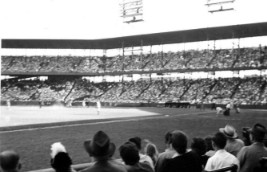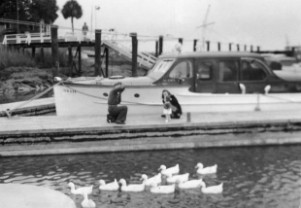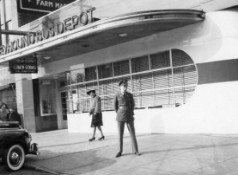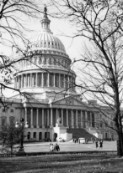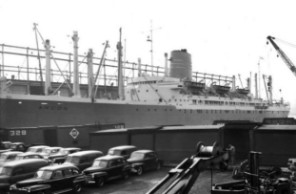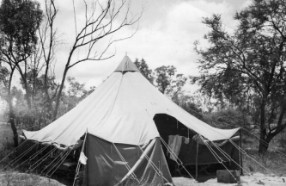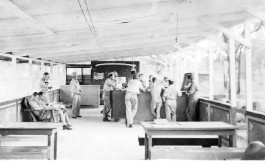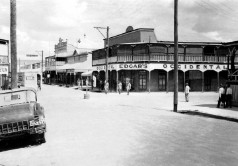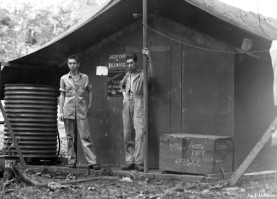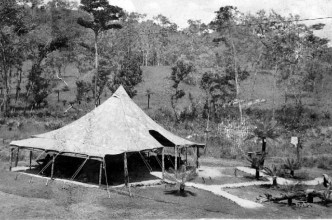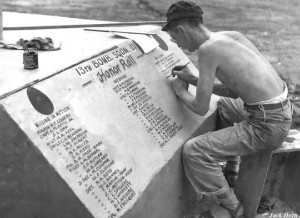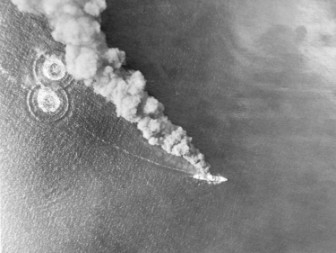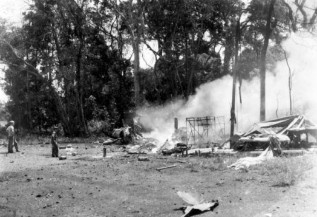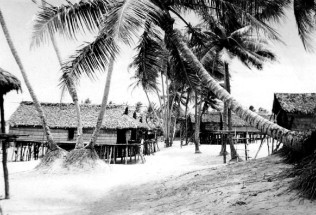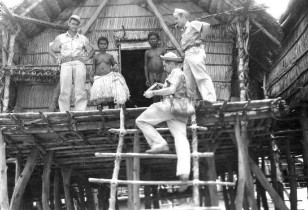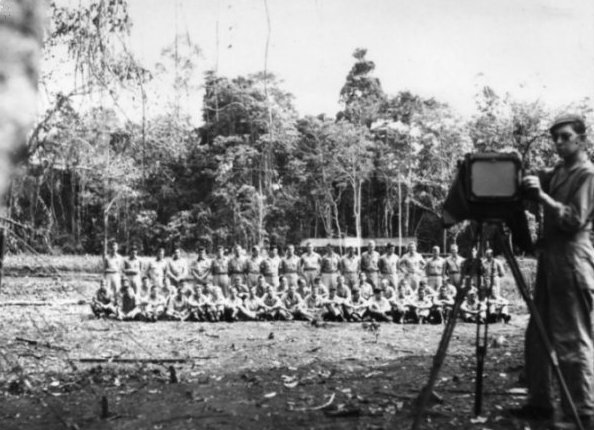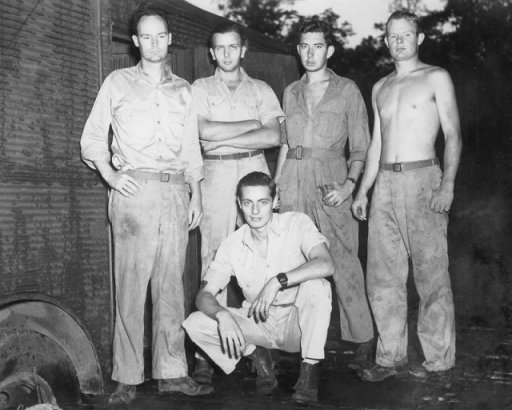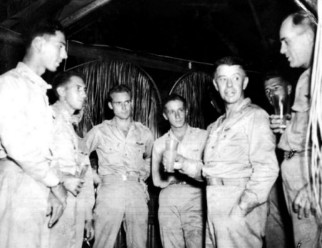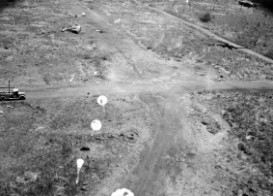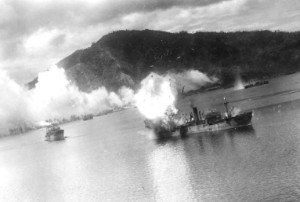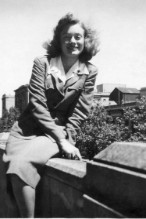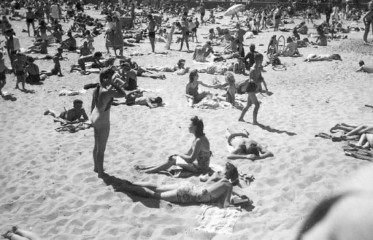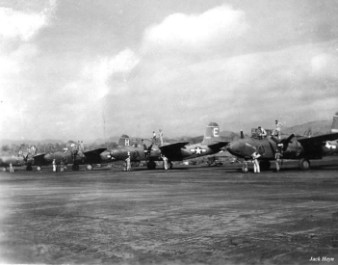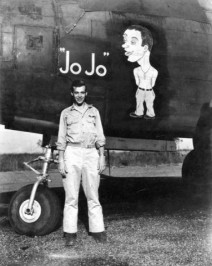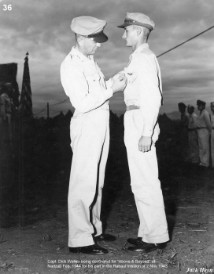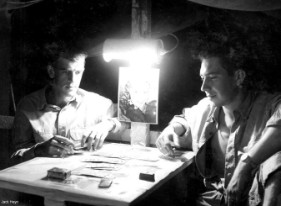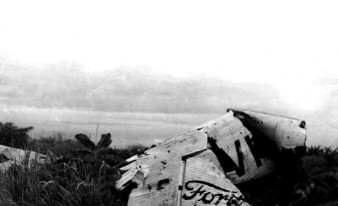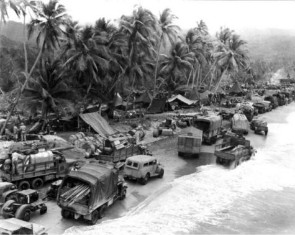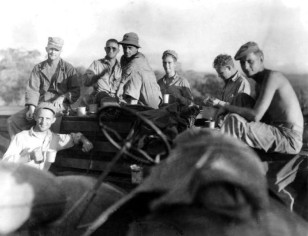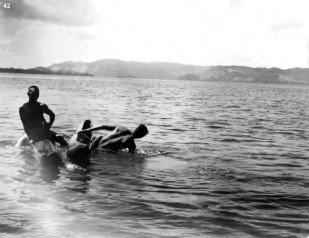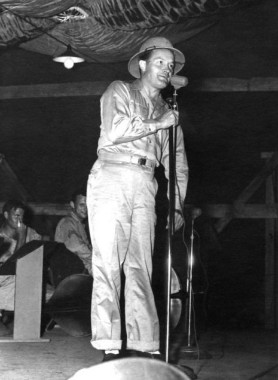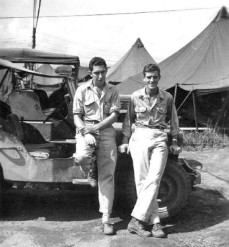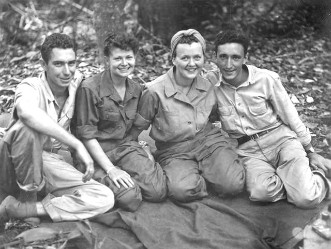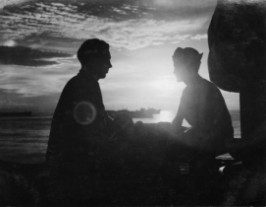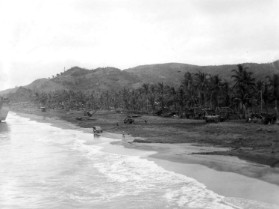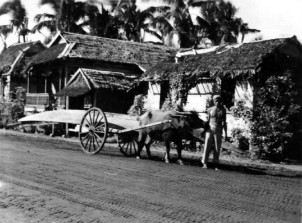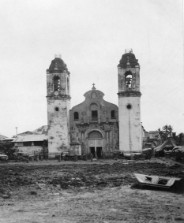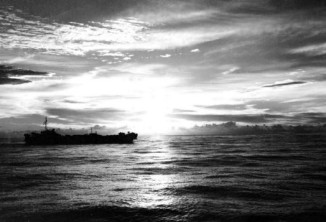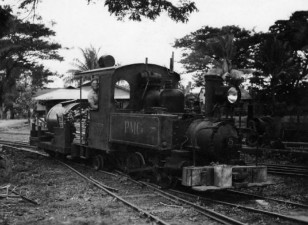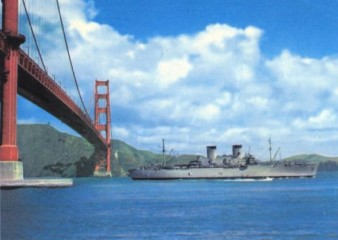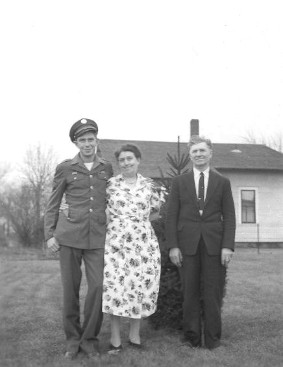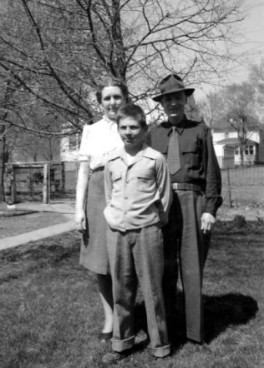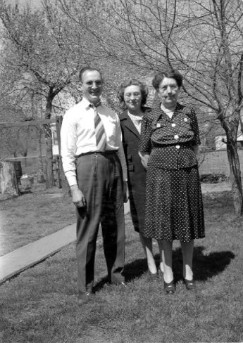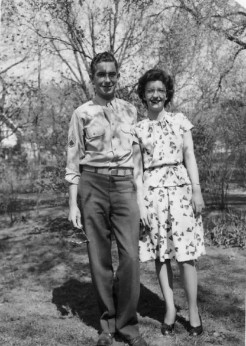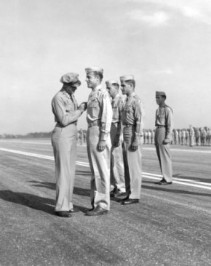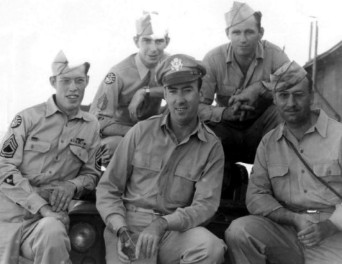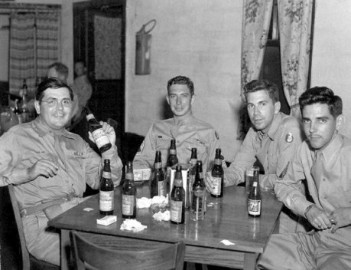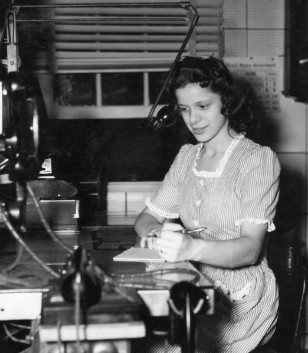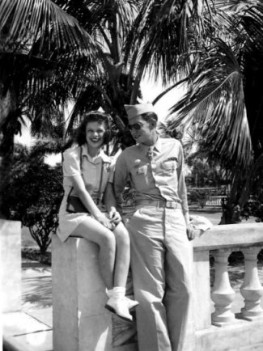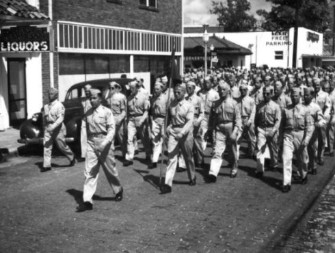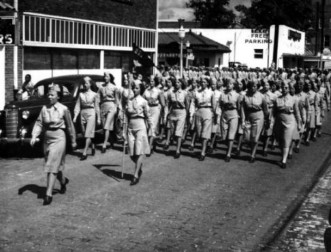Folks,
This will be a thumb nail sketch of the four years in
the Greatest Armed Conflict in the history of mankind, of one
insignificant citizen soldier.It's just that I was a very small part of History, and
will now share it with who ever.
I graduated from Watertown H.S. in May of 1941. Europe had been
engaged in Hitler's war for almost 2 years and it was just a matter of
time before we were involved. The Army Air Corp had a program going,
where if you enlisted you could choose your school. Aug. 29, 1941, I enlisted
at Fort Crook, Nebraska. with the promise to attend the Photography School at
Lowry Field in Denver. My first week was spent at Fort Leavenworth,
Kan. It consisted of orientation, applitude tests and the General
Classification Test. You had to score at least 110 on that to be
Officer material - I scored 141, but had no illusions of being an
officer.
After a week I was sent to Jefferson Barracks at St. Louis (photo 1) for
Basic Training. My basic was a bit of a farce. It rained a good bit
of the time, so mine consisted of some close-order drill and lots of
lectures out of the rain. No obstacle course, no small arms training,
no 25 mile hikes - no nothing that would prepare you to do battle. I
did get into town a time or two, and even got to attend my first major
league baseball game (photo 2), the Cards and if memory serves me right
the Dodgers.
In mid Oct. there were no
openings at the School and I was assigned to Hq. Sq., 3rd Bomb. Gp.
Savannah Army Air Base (photo 3). Having some typing skills I was
assigned to Group Operations as a Clerk
Typist, and informed that I was scheduled to attend School in Jan. '42.
Operations
was on the Hangar Line and this was all very new and interesting to
this Dakota Boy. Even got my first ride in an Airplane, 0-47 -
observation plane. Did get into Savannah couple times, but did not find
it that exciting. Did visit a yacht basin one day (photo 4), why, I
will never know.
In
Dec. they started putting out Christmas furloughs. Being a short timer
I had to take mine early, and only got 7 days. This was not enough
time to get to S.Dak., but I had a Sister working in D.C. and my old boy
hood pal, Erv Von Wald had moved there. On the evening of Dec. 6 I
arrived at the D.C. bus station (photo 5) and met by my Sis and Erv. I
stayed with the Von Walds, and Sun. afternoon Erv and I walked up to
the corner drug store for ice cream. They had the radio on and were
getting the bulletin that the japs were attacking Pearl Harbor. That
nite I received a telegram to report back to base PDQ. Couldn't get a
bus out until Mon. nite so Erv gave me a whirlwind tour of our Nations
Capitol Mon. We were standing out side the Capitol Bldg. photographing
it (photo 6) when FDR was giving his "Day of Infamy" speech.
7
That
nite I boarded the bus and headed back to the base, so much for my
first furlough. The next five weeks were rather hectic ones. We
started packing up for a move, and the Christmas Holidays were a rather
somber time. Jan. 19 we boarded a troop train and headed West. We
spent a week in a huge warehouse in Oakland. Could get short passes to
get into town, and had some dock details helping to load equipment.
About 1:30 AM Jan. 31, '42 we boarded the USS Ancon (photo 7). About
2:30 that afternoon we sailed under the Golden Gate Bridge headed West.
Many of us thought the P.I.
Feb.
25, '42 we landed in Brisbane, Aust. Spent about 10 days at Ascot Race
Track, unloading equipment and loading it back on RR cars. On Mar. 10
we arrived at Charters Towers in N.E. Q'land, where they were building a
new air strip. When we left Savannah they left all our ranking
Officers to form a new Group, and our Aircraft to pull sub duty on the
East Coast. But they had made no arrangements for us to have any
planes. There we sat ready to fight a war with a 1st Lt. Group C.O. and
no aircraft.
In Mar. we recieved 42 Pilots from the 27th Bomb. Gp. in the P.I., and 25 A-24 Dive Bombers that never got to the P.I. Col.
Davies became our Gr. C.O. and some of the Maj. and Capt. became Sq.
C.O.s. Col. Davies got word of 25 B-25 belonging to the Dutch in
Melbourne. He took a group of Pilots with him and they came back with
the B-25s. Still not sure whether they begged, borrowed or stole them.
They were devided between the 13th and 90th Sqs. At any rate we had
something to fight with, and pulled our first combat mission Mar. 31,
'42. That was the start of 42 months of continuous combat duty for the
3rd Bomb. Gp. aka Attack Gp.
Shortly
after arriving at C.T. we had some training sessions; with WW I steel
helmets and Enfield rifles (photo 8). This was our first deployment
away from Stateside Barracks, the tents were a bit primitive (photo 9).
In Aug. '42 they deactivated Hq. as a tactical unit and all the combat crews, mechanics, etc were transferred to the other 4 Sqs. I, too, was
transferred to the 13th Sq. Operations Office. The 13th had an E.M.
Club (photo 10). We could get passes to visit town in the evenings
(photo 11).
Shortly
after my arrival Maj. A. Evanoff set S/Sgt. Marvin Culbreth and myself
up in the 13th Sq. Photo Shack (photo 12). Very unauthorized and very
unorthodox, but I was doing what I had enlisted to do - Photography. We
operated out of C.T. until mid Jan. '43. About the last 3 months we
would alternate 2 Sqs. at Moresby for 2 weeks, and 2 at C.T. for 2
weeks. In mid Jan. we boarded a tramp steamer and headed for Port
Moresy, New Guinea where I would spend the next two years of my youth.
12
In mid Jan. '43 we boarded a tramp steamer and headed for Port Moresby
on the second largest Island in the world, New Guinea. Here we took a
little more pride in our living quarters(photo 13). We had been in
combat for 10 months, and they had been costly in both men and
aircraft. One of the first things we did was build a Memorial to our
lost comrades (photo 14). It was also decided that every thing had to
be on concrete floors including the Mess Hall (photo 15). For about 2
weeks we called our selves the 13th Cement Mixers.
The first
week in March the japs tried to bring a convoy of about 20 ships down
from Rabaul to reinforce Lae. When they got in range of our low level
B-25s and A-20 the 89th and 90ths Sqs. had a field day (photo 16). The
13th was still flying the high level models, and altho they pulled about
3 missions a day, they didn't have as good a luck as the low level
models. After 2 days the convoy was destroyed and about 6,000 jap
troops never made it to Lae. This started our 2 year trek back to the P. I.
April
11, '43 was not a good day for the 13th Sq. About 10:30 in the morning
we had a Red Alert, it would be our first and biggest day lite raid.
Approximately 100 jap bombers came over. One segment broke off and hit
14 Mile Field where the 8 B-25s of the 13th were dispersed. They put 7
of them out of commition, direct hits on Baby Blitz and Fair Dinkum
(photo 17) left burning heaps of ruble.
The
13th sat idle for a month or so waiting to be resupplied with the new
low level models. This did give us a little time to do a little sight
seeing. after all "all work and no play makes Jack a dull boy". About
40 miles up the coast was a native village that we visited (photo 18).
It was one of the neatest ones I saw. But after having an up close look
(photo 19) we appreciated out nice clean tents back in camp. Our stay
at Moresby was short, and in May once again we loaded up and moved to
the North side of the Island to Doba Dura in the Buna Gona area.
19
In
May, '43 we packed up again and went across the Owen Stanley Mts. and
settled in at Doba Dura, in the Buna Gona area. Once again our skills
at getting stuff to improve our living quarters paid off (photo 20).
That summer Marvin and I photographed several different groups (photo
21). Including the Ancon survivors (photo 22). Of the 200 some odd men
that came over on the Ancon, only 64 were still with us. A few had
flown their 50 missions and returned home. The rest were KIA or MIA,
may they RIP.
22
In
Aug. '43 they transferred the Photo Section from the 35th Air Base
Group into Hq. Sq. 3rd Bomb. Gp. That's the outfit that processed all
our mission film. I immediately asked for a transfer back to Hq. and
the Photo Section. I got it, and at last I was doing what I had
enlisted to do. I had experience and was put in charge of one of our
Mobile Lab crews (photo 23). Having had experience with the Speed
Graphic I usually got the assignment to cover special events, like Gen.
Kenny visiting the Officers Club (photo 24): and covering USO troupes.
This one of myself and 2 5th A.F. Photogs with Una Merkle (photo 25) who
was with Gary Cooper's troupe.
25
In
about Sept. the Aussie's landed at Lae, and that was the end of the
japs in that area. We flew air support for the landing (photo No. 26).
Since we were processing all the mission film we had the opportunity to
add mission photos to our collections. We used a lot of Parafrag bombs
on air strips (photo 27), they raised havoc with both aircraft and
personel.
In
Oct. '43 the powers that be decided to neutrilize the big jap naval
base at Rabaul. It was out of range of the B-25s but we used auxiliary
tanks in half the bomb bay. The first raids we loaded up half a load of
Parafrags and hit the airstrips. On Nov. 2, '43 the 3rd Bomb. Gp. and
the 38th Gp. with our modified low level B-25s hit Simpson Harbor and
had a field day (photos 28 & 29) Check the lower left corner of 28,
you can see one of the B-25s down on the deck.
The
end of Dec. I got a 15 day leave to Melbourne, but had to go by surface
transportation. I would miss the move to Nadzab in Jan. but had a ball
in Melbourne. Dancing at the Red Cross Club with Monica Lynch (photo
30). Dancing at Earl's Court (photo 31) with Patty Morris. And
spending some time at St. Kilda's Beach (photo 32). When I got back the
Group was set up at Nadzab.
32
When
I returned from my 15 glorious days in Melbourne, things had changed.
The Group had moved up to Nadzab, about 30 miles up the Markham River
Valley from Lae. They also had a new look. As mentioned early on we
were shipped over seas sans aircraft. The 8th Sq. had flown A-24s and
B-25s, the 13th and 90th B-25s and the 89th had had A-20s. When I got
back, after two years, we finally had four Sqs. of A-20s (photo 33).
The
89th Sq. had taken a little different slant on nose art. They took the
idea from Damon Runyon and had a Sq. full of "characters" (photo 34)
While
based here we had a visit from Gen. Kenny for a decoration formation
(Photo 35) In the photo he is visiting with Col. Henebry. We had
several of our combat crews receive medal that day for "above and
beyond". Capt. Dick Walker received on for his part in the Nov. 2
Simpson Harbor mission (photo 36)
I
hadn't shared a tent with my good friend, Tack Tackaberry since my
first stint with Hq. Sq. At Nadzab we reconnected and we spent a lot of
time playing solataire (photo 37). As mentioned we were up the Markham
River Valley from the port of Lae. That was the airstrip that Amelia
Earhart took off from in July, 1937 and flew off into oblivion. On one
of our sight seeing trips we went down to look the place over. The
strip was lined with bombed out jap bombers, and a plane that caught my
eye.
When
I was five years old one Sat. morning my Dad took me out the the
airport at Rapid City. Clyde Ice was a popular barnstormer in those
days (1928) and had flown his Ford TriMotor in. It was the first time I
had seen any plane close up, and sort of stuck in my memory. Laying
beside the Lae runway were the remains of a Ford TriMotor. (photo 38).
Just couldn't resist photographing it. Our stay at Nadzab was another
short one. In May we packed up, loaded an LST and headed for Hollandia,
Dutch New Guinea.
Our
stay at Nadzab was another short one. In May we loaded up on LSTs and
headed for Hollandia, Dutch New Guinea. We arrived two weeks after the
initial landing and ran into a very crowded beach (photo 39). There was
about 50 yards of beach that backed up to a swamp area. There was only
one road off the beach to where the air strips were. When we got
unloaded there was no way we were going to get off that beach that day,
so we sat and waited (photo 40), and ended up spending the nite on the
beach among 500 lb. bombs. and 90mm artilery shells. The beach had been
bombed three times since the landing, fortunately they did not come
over that nite.
The
next day we got all our equipment off the beach and out to our camp
area. On the way we passed Lake Sentanni; once again when seen thru the
view finder of a camera, New Guinea did have a lot of natural beauty
(photo 41). Later on the Lake provided recreation (photo 42). It also
had a sad note, Sgt. 'HutSut' Houston drowned in it.
During
our six months stay we had several U.S.O. Troupes visit us. The most
noteable being Bob Hope (photo 43). He had singer Francis Langford and
dancer Patty Thomas (photo 44). Maybe you think she wasn't a site for a
bunch of guys who hadn't seen a white woman in months. Also had
Shakespearian Actress Judith Anderon, and girls; and a couple groups of
lesser lights.
I
think it was about July that they started the Rotation System, where
by ground troops were returned to the States. My good friend Tack
Tackaberry was lucky and made the first list and we said our fond
farewells (photo 45). I would wait another six months before I got on
the list. While at this base the WAACs caught up with us, strictly as
support troops. But it was a bit of a blow to our pride to have a bunch
of women catch up with us. The officers had a big welcome party for
them at their club. But they were not off limits to E.M. and one of the
Intel guys arranged a date for a K-ration jungle picnic for us (photo
46).
We continued to fly lots of missions and we kept busy in the dark rooms, but had a new target. For 2-1/2 years our targets had been airstrips, shipping and air support for ground troops. During the campaign to drive the japs back across the Owen Stanleys from Moresby we had learned the meaning of "Friendly Fire". The battle took place under a jungle canopy that you couldn't see anything thru. Our pilots would be given a certain sector to bomb at given time. On one or two occasions the ground troops broke thru ahead of schedule, our pilots didn't know it and they got caught in our fire. As old Sherman said "War is Hell". From Hollandia we had a new and different target, the Bolio oil fields (photo 47).
In
Oct. MacArthur landed on Leyte Island in the P. I. We had always been
the first Bomb Gp. to move up. This time the 38th Bomb. Gp. got the
call. It was a blow to our pride, but we dodged a bullet. While
waiting to land and unload they got hit by jap bombers and suffered
casualties. We would follow them in early Nov., '44.
47
When
we sailed under the Golden Gate Bridge Jan. 31, 1942 a lot of us
thought we were headed for the Philipine Islands. We were right - but
it took us 34 months to get there. The first week in Nov. '44 once again
we loaded up on an LST (photo 48). A few days later we pulled up on a
beach (photo 49) on Leyte Island about 20 miles south of Tacloban. We
made camp right on the beach, and there we sat for six weeks doing
nothing. It was the rainy season on the east side of the archipelico
and there were no airstrips for our planes to operate out of.
But
the time was not without events of note. The first thing that hit us
was a typhoon with 90 mph winds. The next morning there were only 4
tents still standing that had been framed, ours was one of them. Then
there was the nite that nobody got any sleep. There was a fighter strip
about a mile inland from us. We had a red alert one nite, and never
got an all clear. Seems the japs had dropped troops on the airstrip.
We had to put perimiter guards around our camp, and I don't think anybody slept that nite. The next morning the Infantry made short work of the japs.
Then
there was Thanxgiving Day, and it was the second one I spent in the
Hospital with my second bout of Dengue Fever. The first one was in '42
at Charters Towers. Then there was another event of great importance,
we received our first issue of BEER. I guess after almost 3 years they
figured we had earned a free beer.
With
no official business to take care of we did have time to do some sight
seeing. Got into Tacloban a time or two. At home in a residential area
you would see a home with an auto parked in the street and the house
would have shingles. Over here there was an ox cart sitting in the
street and the house had a thatched roof (photo 50). One of the first
things I photographed was a bombed out church (photo 51) - old Sherman
was right "War is Hell". Christmas was nothing to write home about, but
we did have canned turkey.
Dec.
28 we, once again, loaded our equipment on an LST and about midnite
pulled away from the beach. About 10:30 the next morning we were headed
west thru the P.I. Straits towards Mindoro Is. Four of us were playing
cards topside when 3 planes came in low over an Island on our right.
One flew right over our ship and dove into a Liberty Ship one lane over
and one ship back. Ammunition ship, went strait up and mushroomed out -
no survivors. We had come face to face with the devine wind,
Kamakazis. I got a sunset shot (photo 52), the serenity of the shot
belies the gravity of the situation. For the next 48 hours we would be
under attack. They sank 8 ships out of our convoy, but the Navy gunners
shot 25 of them out of the air. Three of them close enough for me to
photograph hitting the water (photo 53).
Mid
morning Jan. 31, '44 we made landfall on Mindoro Is. By nitefall we
had our equipment out to our camp site and prepared to spend the nite
on the ground. I expect that was one of the best New Years Eves a lot
of us ever had; just damned happy to be alive. We got our labs set up
and ready for work, but the planes hadn't arrived before I left. So the
only photos we processed was some of our sight seeing shots (photo 54),
a locomotive. Compared to what we were used to seeing back home, one
guy made the comment that it could'nt pull a sick whore out of bed.
Also got a shot of one of the local Belles, don't ask me here name. (photo 55) Jan. 12, '45 I received my rotation orders, grabbed a C-47 and headed back to Hollandia to await surface transportation.
Jan.
12, '45 I boarded a C-47 and headed for a staging area at Hollandia,
N.G. We had a plane load of returnees that had been over there from
2-1/2 to 3 years - precious cargo. After we had been flying for quite a
while the pilot announced we'd have to land at Biak Island, he has an
engine problem. By all means put this sucker down. After a brief stop
we were on our way and arrived Hollandia with no problems. The next
two months would be spent waiting and sailing across the wide Pacific.
After
checking in at the staging area we were assigned a tent, had to stand
roll call every morning and then we were pretty much on our own. One
day we went down to our old camp area. Doesn't take the jungle long to
claim its own. Could hardly tell there was ever a camp there. One
afternoon while sitting in the tent killing time, the Orderly came by
and said there was a C-54 about to take off for the States. Said they
had room for some passengers, any body interested? In unison we told
him "not no, but hell no". Having spent 3 years down there we were not
about to gamble on a plane getting us home. The memory of Eddie
Richenbacher floating out there for 30 days early in the war was very
much on our minds.
USS A.E. ANDERSON
Feb.
19 we got the call, loaded us on trucks and headed for the dock area.
Waiting for us was the USS General A.E. Anderson troop ship. After we
were all loaded another convoy of trucks pulled up and started unloading
more troops. Some were missing limbs, some had to be carried on on
gurneys and all were malnourished. It was the "Ghost Soldiers", 500
POWs that had been rescued from the infamous Cabanatuan POW camp. Thanx
to their being on board we had the best chow we had ever had on any
kind of surface transportation.
It
took 18 days to make the trip back to Frisco, and we were alone, no
convoy. Three years, one month and eight days after leaving I sailed
back under that Golden Gate Bridge. When we sailed under that bridge we
were met by all the fire boats in the harbor, spewing water high in the
air. Every ship in the harbor were blowing their whistles. We all
knew the welcome was for the POWs on board, but we all soaked a little
of it up. We pulled up to a dock where there were family members of the
POWs to greet them. After they unloaded we pulled over to Angel Island
where the rest of us unloaded. At this point we turned in every thing
we had with us, and were issued all new clothing. Any diaries or photo
albums were confiscated with the promise they would be returned after
the war. Thank heaven my collection was waiting for me at the folks.
I've talked to some that never get their things back.
The
next morning we were loaded on a troop train and headed East. About
6:PM Mar. 12 we pulled into Omaha, Nebr. Our car was sidetracked and
the officer in charge said we'd be leaving at midnite for Fort Snelling,
Minneapolis. I told him it was my birthday and I had a mother and two
sisters living in Omaha. Would it be all right to call them and go have
a birthday dinner with them. He said you don't have a pass, so stay
out of trouble and be back here at midnite. It was probably the best
birthday dinner I ever had, hadn't seen them for 3-1/2 years. Three
days later from Snelling I was turned loose on my 21 day delay in route.
On
Mar. 15, '45 I was turned loose, about noon, from Fort Snelling with
orders in my pocket to report to a Redistribution Center in Santa Anna,
Calif. 21 days later. My first stop was St. Mary's Hospital where my
Aunt, Sister St. Elizabeth, was Asst. Mother Superior. I stopped at the
desk and asked if she was in. The lady asked who was calling, I told
her I was her Nephew just returned from New Guinea. Things went into
high gear, I was given the big welcome and nothing would do but I had to
have lunch with them. Sister asked me what my plans were, told her I
was going to have dinner with a hometown girl who was working for Betty
Crocker, but I had to get a hotel room. Would be leaving town in the
morning. No hotel room, I would have the guest room at the Hospital.
That nite I did have dinner with Mary Anita Fredricks, whom I had kept a
correspondence with while overseas. Strictly a plutonic relationship.
The
next morning I caught a bus for Thief River Falls to spend a couple
days with Jean Richards, a pen pal courtesy Barb Von Wald.
Spent
a couple days with her and family, who were good scandinavian
Lutherns. Her mother was worried we might get serious. No problem, I
had Annie on my mind. Caught a bus out and rode on out of her life.
Back to Minneapolis where I caught the "Galloping Goose" to Watertown.
Reconnected
with family, Mom & Dad (photo 56), Sis & family (photo 57) and
Shirley with new husband (photo 58). I got lucky one of my 3 good H.S.
buddies, Bill MaGee, was home on leave from the Navy. His Dad was a Dr.
so we had plenty of gas to get around. The four of us all served in
the war, Bill in the Navy, Pete McKay Army Medics and Jean Kroeger Pilot
in the Air Force. We all survived the war: cancer took Jean in his
50s, stroke took Bill in his 70s and cancer got Pete in his 70s. I'll
be 87 next month and one has a tendency to wonder "why me?". But that's
the Good Lord's territory, not mine.
After
a week Mom and I got on a bus and headed for Omaha. I had been
busting my buttons to get there. My H.S. flame, Annie, had moved there
and was attending the U. of Nebr. I had carried a torch for her for
3-1/2 years and was anxious to reconnect. Spent an afternoon with her
and family (photo 59). Made a date to take her dancing the next nite at
Peony Park and was looking forward to spending a nite dancing with my
dream girl. One date, and the torch was extinguished. I had left a 16
year old Jr. in H.S., came back to a 20 year old Jr. in college. Just
wasn't the same girl. Took her home that nite and walked on out of her
life
After
a week I caught a train and headed for Santa Anna, Calif. They said we
would be there 2 weeks, maybe more. The first first few days we had
orientation sessions, also had to fill out a questionaer giving a list
of 3 bases we would like to be assigned to. I listed one in Mich., N.
Dak. and Mont. all up against the Canadian border. After that we could
come and go as we pleased. They had a 24/7 Mess Hall where you could
order anything you wanted, including T-bone steaks - this was the
Army??? I got into the famous Hollywood Canteen, and a USO club where I
met Jeanette Johnston and spent a lot of time with her and family. The
second weekend I was there I checked the shipping list Sun. nite, and
there I was. Would be shipping out the next morning for Page Field, Ft.
Meyers, Fla. -- so much for the Canadian border.
Monday
morning, the last week in April, I boarded a train for a cross country
trip to Ft. Meyers, Fla. They couldn't have sent me any further south
and kept in me the country. I was headed for Page Field, a P-51
training base. Must have really been a slow moving train. Mid
afternoon the last Sun. of April we pulled into Ft. Meyers. Took a cab
to the bus station where I would catch a bus out to the base. While
waiting, this perky little brunette walked in and sat down across the
room. She had on a pink, candy stripe cotton dress and looked so neat
and clean - like the girl next door was supposed to look. Thought to
myself, there is a girl I'd like to know. She got on the Page Field bus
but was too far ahead for me to get close to.
Got
out to the base and checked in to the Orderly Room of Sq. T. Showed my
way to a cot in the barracks and advised that I would be working in the
Photo Section. Next morning I made myself known there and welcomed.
There principal duties was processing movie film taken in training
dog-fight missions. I had never worked with movie film, so had some
learning to do. The base was manned by "USO Commandos". These guys had
been there up to two years, never served overseas. They were just
starting to get some returnees in. Carol Hebble had just got back from
2-1/2 years in Karachi, India. He and I hit it off pretty good. We
also found we pretty much were on our own, could come and go pretty
much as we pleased.
Once
again my Speed Graphic experience paid off. When ever there was any PR
shot to be taken, I got the assignment. All the instructors were
combat Veterans and one day we had a decoration formation for "above and
beyond" medals (photo 60). One day we got a group of 5 returnees
together for a group shot (photo 61). Between the 5 of us we had 13
years overseas duty. Frequently after work the guys at the Section
would head for the P.X. for a cold one (photo 62) - make that several
cold ones.
62
About
2 weeks after I got there I was in town for a movie. Got to the bus
station just in time to catch the last bus to the base. There she was
again, in line about 5 guys ahead of me. This time I got the seat next
to her. She wasn't too anxious to strike up a conversation with a
strange G.I., but I got out of her that she was a CAA Radio Operator
(photo 63) headed out to the base for the graveyard shift. Her name was
Evelyn Johnson - called Jonnie from the Johnson bit - from Kansas.
Talked her into walking her across the field to the Radio Shack. Before
leaving I talked her into a date for a movie. That started 4 months of
whirlwind courtship. When ever she had time off I was usually able to
be with her (photo 64). We spent a lot of time together dancing,
picnicing, movies and swimming (photo 65 my personal PinUp Girl). In
July she had a weekend off and I got a weekend pass and we spent the
weekend in Miami - in separate hotel rooms. Sunday nite on the way back
to Ft. Meyers on the Tamiami Trail I asked her to marry me - she
accepted.
65
They
had started a system where by if you had 60 points you could be
discharged. Hebble and I both had 115 points but our MOS No. was
frozen. Weren't letting any Photo Labtechs out. Don't know why there
always seemed to be a shortage of us guys. One day in July the 1/Sgt
called us up to the Orderly Room. There were openings for two
instructors at the School at Lowrey, it would be an increase in grade.
Were we interested. I looked at Hebble, he looked at me and in unison
we said "hell no, we want out".
Aug.
6, 1945 they dropped the A-bomb on Hiroshima. Aug. 9 they dropped
another one on Nagasaki. Aug. 15 they sued for peace and just 2 weeks
short of 6 years the greatest armed conflict in the history of mankind
came to a halt. We had a V.J. Victory parade in down town Ft. Meyers.
Rather than march in the parade - I photographed it (photos 66 &
67). When I was sworn in at Ft. Crook back in '41 I was asked if I had
any objections to combat. Told them no, but my weapon of choice would
be a camera.
On Sept. 5, '45 I was handed a Certificate of Appreciation signed by Hap Arnold, an Honorable Discharge and sent on my way. Didn't take them long to get rid of you once they were thru with you. And so ended four years of my youth donated to my country. As the old saying goes "I wouldn't take a million dollars for the experience, I wouldn't do it again for ten million". Altho I really think all 16.2 million of us that served, would do it again.
Jack
WW II Ancient One.


